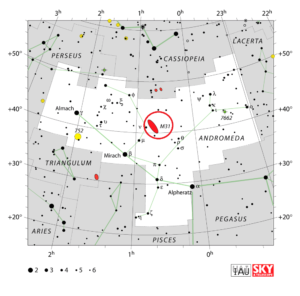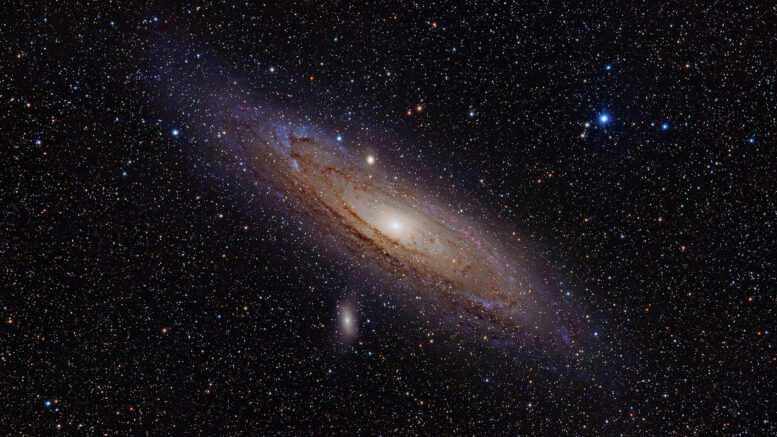Messier 31, which is better known as the Andromeda Galaxy, is a large spiral galaxy located in the constellation Andromeda. The Andromeda Galaxy was named after the area of the sky that it occupies, the constellation Andromeda, which represents the princess Andromeda in Greek mythology. Andromeda was chained to a rock and left to a sea monster to appease Poseidon after her mother Cassiopeia had boasted that her daughter’s beauty surpassed that of the sea nymphs. The princess was saved by Perseus, the Greek hero represented by the neighbouring constellation.
The Andromeda Galaxy contains a trillion stars, more than twice as many as the Milky Way, which is home to 200 to 400 billion stars. The two galaxies are roughly equal in mass and will collide in about 3.75 billion years. The collision will likely result in a new giant elliptical galaxy or disk galaxy being formed.
| Description | |
| Visible From Pacific Northwest | July To January |
| Best Time To Observe | October, November and December |
| Minimum Size Of Viewing Device | 10×50 binoculars |
| Object Type | Spiral Galaxy |
| Designations | Messier 31, M31, Andromeda Galaxy, NGC 224, LEDA 2557, Bode 3, Flamsteed 58, PGC 2557, UGC 454, Hevelius 32, GC 116, CGCG 535-17, MCG +07-02-016, IRAS 00400+4059, 2MASX J00424433+4116074, h 50, Ha 3.3, IRC +40013, GIN 801, DA 21, K79 1C, RAFLG 104, 2C 56 (core) |
| Right Ascension | 00h 42m 44.3s |
| Declination | +41°16’9” |
| Constellation | Andromeda |
| Number Of Stars | 1 trillion |
| Apparent magnitude | +3.44 |
| Apparent dimensions | 190′ x 60′ |
| Object Radius | 110,000 light years |
| Distance From Earth | 2,540,000 light years |
History
The earliest record of M31 comes from the Persian astronomer Abd al-Rahman al-Sufi, who mentioned the chained constellation, referring to Andromeda, or the Chained Maiden, in his Book of Fixed Stars in 964. Al-Sufi described the Andromeda Galaxy as a “small cloud.”
The first documented telescopic observation of the galaxy was provided by the German astronomer Simon Marius on December 15, 1612.
Charles Messier credited Marius for the discovery of M31, unaware of the Persian astronomer’s earlier observations.
William Herschel, who first observed the object on August 6, 1780, believed the Great Andromeda Nebula to be the nearest of all the “great nebulae” in the night sky. He incorrectly estimated the distance to M31 to be no more than 2,000 times than that to Sirius, which lies 8.611 light years from Earth
In 1887, Welsh engineer and amateur astronomer Isaac Roberts took the first photographs of the Andromeda Galaxy from Sussex, England. His long-exposure images revealed the galaxy’s spiral structure for the first time.
Locating M31 In The Sky
The Andromeda Galaxy is relatively easy to find in the sky as it is one of the brightest Messier objects. It lies in the vicinity of two prominent asterisms in the northern sky: the Great Square of Pegasus and Cassiopeia’s W. The only objects listed in Messier’s catalogue that are brighter than M31 are the Pleiades (M45) and the Ptolemy Cluster (M7).

Viewing M31
The Andromeda Galaxy is one of the most distant deep sky objects visible to the naked eye. In 10×50 binoculars, the galaxy appears as an oval shaped cloud with a bright nucleus. Binoculars and small telescopes reveal only the galaxy’s bright core, but larger instruments show its full size, which is six times larger than the apparent diameter of the full Moon. The Andromeda Galaxy’s brightest companions, the dwarf galaxies Messier 32 and Messier 110, can also be seen in binoculars.
Photographing M31
Messier 31, the Andromeda Galaxy is a very popular target for astrophotographers of all skill levels. The galaxy is very large and very wide, so using a relatively wide angle view too capture the galaxy is important.
There are many options to capture M31, from using a CMOS and auto guiding scope to an unmodified DSLR and tracking. As such, there are a plethora of available options, which includes using a DSLR for 2 second exposures, ISO 200 at f/2.0 for a photo that resembles M31 to using a 6 inch telescope to get the entire area in the scope with 5.5 hours of exposure using a CMOS camera for a detailed view. It is definitely possible for everyone a specific skill level to photography M31.
Sources And Further Reading
Descriptions of all of Messier Objects can be found here.
https://www.nasa.gov/feature/goddard/2017/messier-31-the-andromeda-galaxy
https://www.galactic-hunter.com/post/m31-the-andromeda-galaxy

How is it that just anybody can write a blog and get as popular as this? Its not like youve said anything incredibly impressive more like youve painted a pretty picture over an issue that you know nothing about! I dont want to sound mean, here. But do you really think that you can get away with adding some pretty pictures and not really say anything?